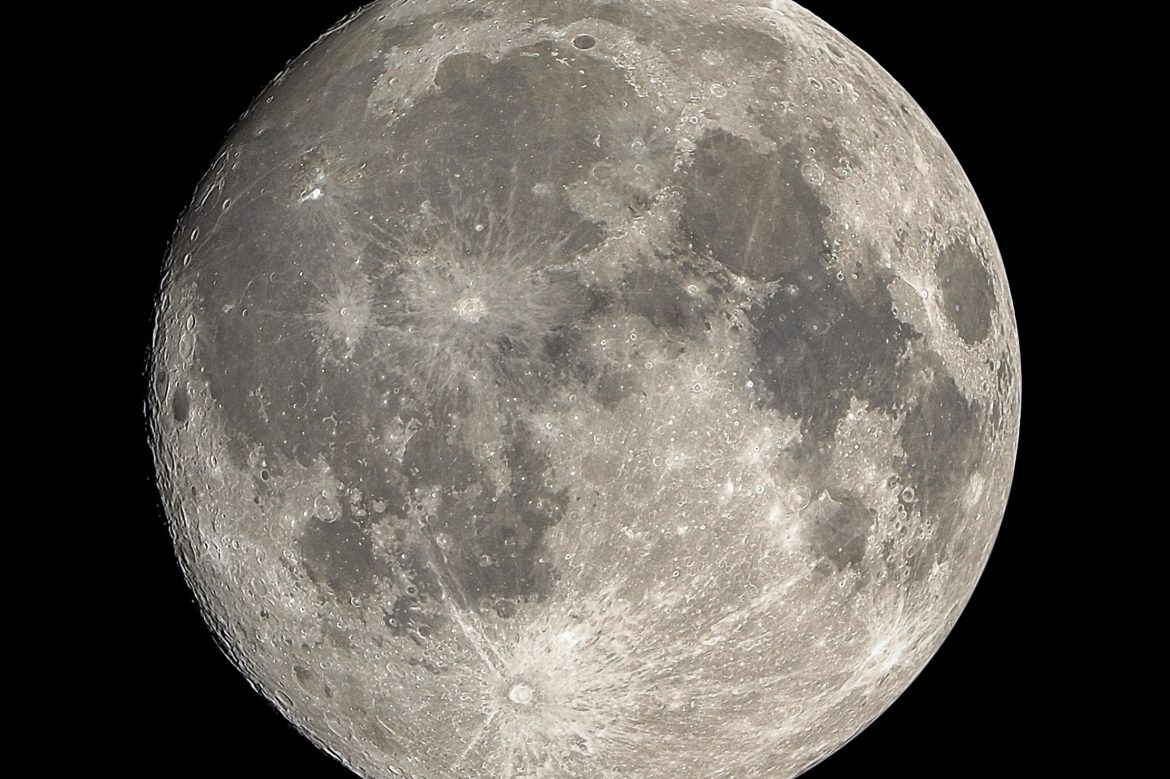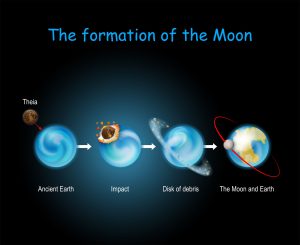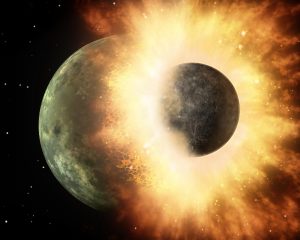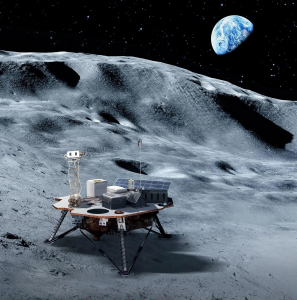
Our Eternal Companion, the Moon
The pearl of the night sky, the Moon, has always drawn great attention. Inspiring countless poems, songs, and works of art, the Moon was also at the centre of scientific observations, research, and studies -even before “science” itself was given a definition. It was the first important celestial body observed by Galileo, who recorded its different phases by using the telescope he made. Once the humans were able to develop the technology to venture beyond the planet, the first and only celestial body they could set foot on, other than Earth, was also the Moon.
As humankind’s interest in the Moon has peaked in recent years, we wanted to make a recollection of what we know about our beautiful satellite that is at the core of many scientific and technological projects. We have compiled what we know about how the Moon formed, its characteristics, its impact on life on Earth, and future plans for the Moon.
Formation of the Moon
The most widely accepted idea about the formation of our Moon is the Giant Impact Hypothesis. This hypothesis suggests that around 4.5 billion years ago, when the Earth was still a very young planet, a Mars-sized celestial body called Theia collided with the Earth, ejecting debris from the Earth’s mantle, which eventually formed the Moon.
The power of this incredibly violent collision between Theia and the Earth caused a massive explosion that evaporated large amounts of material from both celestial bodies. The debris from this collision was hurled into an orbit around Earth and formed a disk of debris. In time, this debris started to pack together due to gravitational forces. As the masses grew larger, they began to attract other debris, forming proto-planets. These proto-planets continued to grow by merging, finally forming the Moon we see today.
An important aspect of the Giant Impact Hypothesis is that it helps to explain some features of the Earth-Moon system. The Moon has a relatively small iron core that is less dense than that of the Earth. Computer models of the scenario where a Mars-sized object collides with the Earth indicate that the impactor’s core is very likely to penetrate the Earth and fuse with its core. As the Moon is suggested to have formed from ejected material that was not fused with the Earth, the Moon would naturally contain less metallic iron than other celestial bodies –which is consistent with the data we currently have. The fact that the Moon’s orbit is nearly circular and lies on the same plane as the Earth’s equator also supports the view that the Moon was formed from debris thrown into a disk-like structure orbiting the Earth.
The main source of objections to the Impact Hypothesis lies in the difference between the elemental composition of the Moon and the Earth. When compared to the Earth, some elements in the Moon’s structure are found in higher proportions and some in much lower proportions. For example, the lunar mantle contains a higher percentage of iron. Still, this is the most widely accepted scenario for now. Here are a few of the other views on the formation of our Moon, put forward over the years:
Accretion Hypothesis: This hypothesis proposes that the Moon formed at the same time as the Earth, from the same cloud of gas and dust (the accretion disk) that makes up the rest of the Solar System. According to this scenario, the Moon is a celestial body that formed in a region close to Earth and gradually migrated towards its present position. The hypothesis fails to explain the angular momentum of the Earth-Moon system and some features of the Moon’s composition.
Fission Hypothesis: This scenario suggests that the Moon was once part of the Earth, which was spinning so rapidly that it expelled a piece of its mass. According to this hypothesis, the Moon should have originally formed from the material that was part of the Earth’s mantle. However, the composition of the Moon is slightly different from the Earth’s mantle.
Capture Hypothesis: This scenario states that the Moon, originally a free-floating object in space, was later captured by the Earth’s gravitational pull. According to this hypothesis, the Moon must have formed elsewhere in the Solar System and was pulled into Earth’s orbit. However, the fact that the Moon’s orbit is nearly circular and is aligned with Earth’s equator makes this scenario unlikely. Also, the oldest known lunar rock is 4.3 billion years old (similar to Earth’s), suggesting that the Moon could not have formed before Earth.
Multiple Impacts Hypothesis: This hypothesis proposes that the Moon is formed from debris created by multiple collisions of large asteroids with the Earth. According to this idea, the Moon was formed as the result of a series of impacts over time, rather than a single devastating one. This is a scenario that is still being debated but not yet widely accepted.
How the Moon formed is a fascinating subject that has captured the imagination of both scientists and the general public for years. Despite the remaining uncertainties, the Giant Impact Hypothesis offers the most convincing explanation yet of how our nearest celestial neighbour came to be. Plus, it may have led to the birth of our Moon in a matter of hours, according to a new simulation.
What if the Moon did not exist?
Two critical requirements for life to arise on a celestial body are the presence of a liquid layer right outside its core and a satellite orbiting it. The liquid layer outside the core creates a magnetic shield that protects the celestial body from s star’s harmful rays. This is essential for preventing the molecules from breaking down in a short time. The satellite, on the other hand, ensures that certain conditions on the celestial body remain stable. So, what does the Moon keep stable?
When the Moon first formed, it was much closer to Earth -a little too close. At that time, the Earth was spinning pretty fast, with one day lasting only about six hours. During the same period, the Moon had a great tidal influence on Earth. Our planet was constantly experiencing strong tides. Many researchers believe that this period was a time when a great number of rapid synthesis and breakdown reactions occurred, which may have eventually yielded the precursors of nucleic acids (RNA and DNA), the very first step of life. The reason why Jupiter’s moon Europa is considered a strong candidate for finding evidence of life is the fact that Europa also experiences frequent and strong tides -although any organic molecule that may form there is unlikely to last long enough due to harsh conditions.
As the Moon’s gravitational pull continued to act on Earth, our planet began to slow down. With days becoming longer, the tides got more stable, and the climate conditions began to turn more favourable. However, as the Moon slowly moved away from us, drastic climate changes took place. During some part of this period, life had already spawned on Earth, and organisms began to migrate to cope with these climate changes. This led to an increase in the number of species. The Moon’s tidal effect also played a role in this increase, as it could have encouraged life to move from the oceans to land. Another consequence of the Moon’s tidal effect at its current position is the conduction of heat from the equatorial region to both poles. Without this effect, the equatorial region would be too hot, the poles too cold, and the survival of many species would be at risk.
One of the most important roles of our Moon is that it keeps the Earth’s axial tilt stable in the long run. The Earth’s axis does not sit perpendicular to its orbital plane, but with a slight inclination of 23.5 degrees, which is the cause for the existence of seasons and different climates. The Moon’s presence ensures that this tilt changes by only 1 degree (back and forth) over hundreds of thousands of years. As a result, the climates can follow a stable course. Without a moon, it is predicted that there would be 10-degree changes in the Earth’s axial tilt, which means very serious climate changes that life could hardly withstand.
Apart from these, the Moon’s existence plays a critical part in the migration patterns of many species, and birds in particular. More importantly, several biological rhythms in the life cycles of a number of species are based on the Moon. Without our moon, life would perhaps follow a very different evolutionary line, and many species, including humans, would not have emerged.
Sometimes, size does matter
When compared to the other planets of the Solar System, the Earth is actually not a too big planet. Its moon, however, is quite large and in fact the largest in the Solar System in proportion to the size of its host planet. Let’s think about the other rocky planets: Mercury and Venus have no moons at all, while the two moons of Mars are relatively small.
If the Earth had not collided with a Mars-sized celestial body, as suggested by the Impact Hypothesis, it would not have reached its current mass and volume. As a result, it would not be able to have a liquid layer surrounding its core or hold oxygen in its atmosphere. Of course, the Moon also would not be large enough to have such a stabilizing effect on Earth.
The researchers’ findings show that rocky planets larger than six Earth masses and icy planets larger than one Earth mass form completely vaporous disks of debris when they collide with another massive celestial body. An all-vapour debris disk is not capable of forming a proportionally large moon.
Even though some experts think that the existence of a large moon is not essential for life, they agree that its presence accelerates and stabilizes certain processes. For this reason, the search for life elsewhere in space often involves considering the existence and size of potential satellites around habitable planets.

What we know about the Moon
The lunar crust is about 56 km thick and mainly composed of oxygen, silicon, iron, calcium, and aluminum. It also contains trace amounts of hydrogen, potassium, thorium, titanium, and uranium. All these elements are found in different percentages on Earth and the Moon. Below that, lies the lunar mantle with a 900 km radius, and an extremely hot iron core with a 768 km radius. The Moon’s total radius is 1,738 km. Earthquakes are not unique to our world. Measurements have proven the existence of moonquakes although the causes of lunar seismic activity are different than those on Earth. You can read the details on moonquakes in our previous article.
The Moon has a size that is only 2 percent of the Earth, and a mass about one 80th of it. Due to this small mass, lunar gravity is about six times weaker than that of the Earth. Consequently, the Moon cannot trap gases and thus has almost no atmosphere, liquid water cannot accumulate on its surface, and the temperature differences between day and night are very high. At its equator, the temperatures are around 130°C during the day and -200°C at night. Measurements taken by China’s Chang’e 4 vehicle and published towards the end of 2020 indicate that the level of radiation on the lunar surface is about 200 times higher than what people on Earth are normally exposed to.
The Moon revolves around Earth at an average speed of 3,681 km per hour and completes one full orbit in 27 days, 7 hours, 43 minutes, and 11.5 seconds. We always see the same side of the Moon, since the time it takes to complete one rotation around its axis is almost equal to this.
Although the Moon is the brightest object in the night sky for us, it is in fact quite dark compared to other objects. According to the “albedo” system, which evaluates the brightness of celestial bodies, the Moon is the darkest object in the Solar System together with Mercury.
Despite its empty and desolate appearance, we now know that there is water on the Moon. Detected in ice form in the permanently shadowed and therefore very cold lunar regions, water is trapped in dust and minerals above and below the surface. Water is thought to have been brought to the lunar surface via comets.
Preparations for inhabiting the Moon
Will it be possible for humans to live on the Moon? We know that the most important prerequisite for life is water. First of all, it was necessary to find out whether water existed source on the Moon since it would not be feasible to constantly transport large amounts of water. Lucky for us, NASA’s SOFIA mission in 2020 detected that there may be water on and around dust particles on the lunar surface. Earlier theories suggested the possibility of finding frozen water in lunar regions that are not exposed to sunlight. However, studies conducted by the Indian Space Research Organization and NASA in 2009 showed the presence of oxygen and hydrogen molecules in the Moon’s sunlit regions. The presence of frozen water in the Moon’s constantly dark regions was confirmed in 2018, and we figured out in 2020 that approximately 350 ml of water can be extracted from each cubic meter of lunar soil. To sum up, it looks like we will not need to take with us the water necessary for our survival on the Moon.
Another important prerequisite is food production. Despite the previous attempts to produce edible plants in a low-gravity environment, probably the most important progress was made in 2022. Scientists succeeded in germinating plants in regolith brought from the Moon. Regolith is the loose blanket of dust, broken rocks, and stones that cover the main solid rock on the lunar surface. Nearly all of the seeds planted in the lunar soil germinated, although it was necessary to supply the plants with an external application of liquid nutrients. So, it is also possible to grow plants on the Moon. In addition, we also learned that the lunar soil contains oxygen in amounts of around 40-45% -even though we are yet to figure out how to extract it. Therefore, it may also be possible to supply our own oxygen required for use as fuel and to breathe directly on the Moon.
One of the most intriguing questions is how humans will build shelters on the Moon. Which building materials will we use and how? As for water and food, we have to be able to obtain the necessary construction materials directly from the lunar surface as their transport from the Earth, even if possible at the initial stages, is not sustainable in the long run. Currently, the most ideal method in this regard is to simply build structures using 3D printers. Studies carried out by Berok Khohnevis, who also works at NASA, attract a lot of attention. Technologies being investigated involve heating the lunar soil to obtain a paste-like consistency like cement-mortar and using this material as a building material in 3D printers. Using a similar method, it is possible to manufacture lunar bricks to use in construction. To provide the heat required for this process, mirrors and lenses could be used for focusing sunlight.
Like NASA, the European Space Agency also dreams of building a village on the Moon and currently discussing long-term infrastructure work as they consider communication and access lines, as well as resources like water, oxygen, and electricity from solar energy. As we plan humankind’s return to the Moon with the Artemis Program, even if we may not yet create a lunar village in the next ten years, it seems possible to create the necessary infrastructure for this with the help of consecutive visits.
Future Plans for the Moon
A number of future lunar plans have been proposed by various space agencies and private corporations. The most notable is perhaps NASA’s Artemis Program, which aims to land the first woman and the next man on the Moon by 2024. This will be the first time humans will set foot on the Moon since the Apollo 17 mission in 1972. The aim is to establish permanent and sustainable facilities on the Moon by the end of the decade, including a lunar gateway station, and developing the infrastructure for scientific and commercial activities on the Moon. You may find the details of this program in an article from last year.
The Moon is a valuable resource for scientific research. Therefore, several missions are also on the way to study its geology, mineralogy, and other features. For example, NASA’s Volatiles Investigating Polar Exploration Rover (VIPER) mission is scheduled to launch in 2023 to study the distribution of water ice on the lunar surface.
The construction of a telescope on the lunar surface, especially on the Moon’s “back” side that is not visible from the Earth, has also been brought up many times with different ideas. The main advantage of a lunar telescope is that it can be free from a number of disturbances that affect the telescopes on Earth, such as atmospheric turbulence and light pollution. This would allow astronomers to observe the universe with unprecedented clarity and detail.

The Lunar Surface Electromagnetics Experiment – Night (LuSEE-Night), a joint work of NASA and DOE (US Department of Energy) is currently the closest lunar telescope project to come true. On the far side of the Moon, LuSEE-Night will listen for radio signals from the so-called Dark Ages, between 380,000 and 400 million years after the formation of the universe. Scheduled to launch in 2025, LuSEE-Night is considered a research step for more advanced telescopes.
On the other hand, several private corporations such as SpaceX, Blue Origin, and Astrobotic are planning to launch their own lunar missions in the near future. These “commercial” missions will include sending spacecraft to the Moon in order to conduct scientific experiments and establish potential lunar mining operations.
Some companies are also exploring the idea of lunar tourism, where individuals can get a first-hand experience by traveling to the Moon. While the concept is still in its early stages, it is already receiving a lot of attention and could become a reality within the next decade.
REFERENCES
- 1. https://moon.nasa.gov/
- 2. https://interestingengineering.com/science/formation-of-moon-5-theories
- 3. https://www.nasa.gov/feature/ames/lunar-origins-simulations
- 4. https://www.space.com/moon-far-side-telescope-universe-dark-ages
- 5. https://www.scientificamerican.com/article/moon-life-tides/
- 6. https://www.nature.com/articles/s41467-022-28063-8
- 7. https://phys.org/news/2015-11-moon-life.html
- 8. https://astronomy.com/news/2019/05/giant-impact-hypothesis-an-evolving-legacy-of-apollo
- 9. https://www.nasa.gov/offices/oct/home/niac_countour_crafting.html
- 10. https://www.bbc.com/future/article/20230317-the-epic-quest-to-build-a-permanent-moon-base
